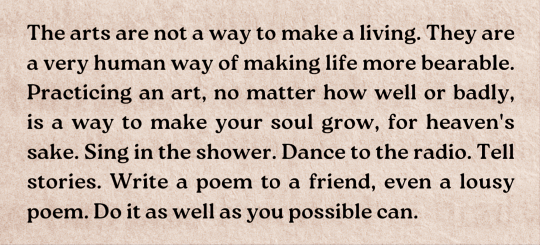Text
Let's talk about misdirection.
Misdirection in storytelling, through foreshadowing and other techniques, is a powerful tool that can enhance suspense, surprise, and engagement in your narrative and make plot twists more unexpected.
Remember to maintain coherence and avoid contrivances that may undermine the integrity of your storytelling.
Here are some techniques you can use to effectively misdirect readers:
Red Herrings: Introduce elements or clues that suggest a certain outcome or plot direction, only to later reveal that they were misleading. These false leads can divert readers' attention away from the true resolution.
Selective Detailing: Highlight certain details or events in a way that implies their significance, while downplaying or omitting others that might be more relevant to the actual outcome. By controlling what information readers focus on, you can steer their expectations.
Character Misdirection: Use characterisation to mislead readers about characters' true intentions, motivations, or identities. Create multi-dimensional characters who may behave ambiguously or inconsistently, leaving readers unsure of their true allegiances, motivations, or goals.
Foreshadowing: Employ foreshadowing to hint at future events or outcomes, but do so in a way that misleads interpretation. Provide clues that could be interpreted in multiple ways or that lead readers to expect one outcome while delivering another. (See my previous post about foreshadowing for more!)
Misleading Narration: Utilise an unreliable narrator or perspective to present events in a biased or distorted manner. Readers may trust the narrator's account implicitly, only to discover later that their perceptions were flawed or intentionally deceptive.
Subverting Tropes: Set up situations or scenarios that seem to follow familiar narrative tropes or conventions, only to subvert them in unexpected ways. This can keep readers guessing and prevent them from accurately predicting the story's trajectory.
Parallel Storylines: Introduce secondary storylines or subplots that appear unrelated to the main narrative but eventually intersect or influence the primary plot in unexpected ways. This can distract readers from anticipating the main storyline's developments.
Setting: Manipulate the setting or environment to create false impressions about the direction of the plot. For example, presenting a seemingly idyllic setting that harbors dark secrets or dangers.
Timing and Pacing: Control the pacing of your story to strategically reveal information or developments at opportune moments, leading readers to draw premature conclusions or overlook important details. (See my post on pacing for more tips!)
Twists and Reversals: Incorporate sudden plot twists or reversals that upend readers' expectations and challenge their assumptions about the story's direction. Ensure that these twists are logically consistent but sufficiently surprising to catch readers off guard.
Happy writing!
2K notes
·
View notes
Note
how do you stop feeling like a fake? i feel like i have nothing to show bc almost everything I've written is either half done or feels like I'm lacking something. I like what I write when I'm hit w emotions and everything flows in the moment but only writing when that happens would mean that I'll have very few things written, but trying to flesh out a vague idea feels like I'm forcing it
Feeling Like a Fake
A fake what? A fake writer?
You're still a writer even if you haven't finished a story yet. Just like you're still a knitter if you haven't completed a garment, and you're still a woodworker even if you haven't completed a single piece of furniture. Being a writer just means that you write... it means you put words and thoughts and feelings on paper and try to make sense of them.
As for the rest of it:
youtube
You will get there. Keep going!!! ♥
•••••••••••••••••••••••••••••••••
I’ve been writing seriously for over 30 years and love to share what I’ve learned. Have a writing question? My inbox is always open!
LEARN MORE about WQA
SEE MY ask policies
VISIT MY Master List of Top Posts
COFFEE & FEEDBACK COMMISSIONS ko-fi.com/wqa
118 notes
·
View notes
Text
A theme is an argument a story is making about life. But it’s not really an “argument” if no one is disagreeing. For every argument, there should be a counterargument, an “anti-theme.”
Some say a story is only as good as its antagonist. Well, a theme is only as good as its “anti-theme.” When you give the opposition teeth, both the protagonist and theme will grow even stronger.
Here are some thematic arguments that I love 😊


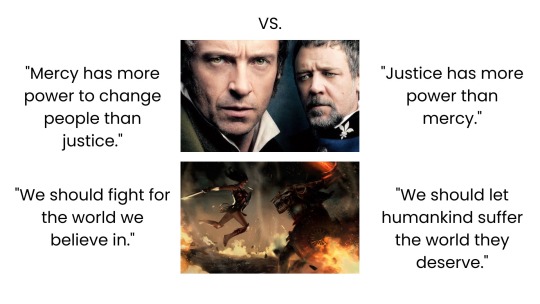
512 notes
·
View notes
Text
“If you focus on results and finding shortcuts, you’ll get impatient. If you focus on the process and doing the right thing, you’ll be unstoppable.”
— Maxime Lagacé
208 notes
·
View notes
Text
Writers, Prepare to Be Wrong
I used to never take risks. Never. I was one of those kids who had everything in order, always got straight A’s, and did everything by the book. I figured out quickly what was expected of me and did that, which made my teachers and bosses happy, and sometimes I’d do something that made me stand out a little.
And I mean a little.
Continue reading Writers, Prepare to Be Wrong

View On WordPress
20 notes
·
View notes
Text
What "Pantsing" Really Means and Why Most Writers Have It All Wrong
If you’re a writer with even minimal involvement in the online writing community, chances are that you’re familiar with the terms, “plotter,” and “pantser.” And if you’re a plotter who manages to successfully finish books—and by “successfully” I mean get out a sloppy first draft with a rough approximation of a beginning, a middle, and an end—then you probably don’t have much angst about being a…

View On WordPress
4 notes
·
View notes
Note
I’m writing a novel that I’ve been working on for years. I recently read a book that contained a LOT of worldbuilding concepts that are very similar to my own, though our plots are different. I’m worried readers will think I ripped off this other novel even though we clearly both had the same ideas independently (a magic system based on a particular way real-word science works, and the aesthetic look of a character including their signature wound). How do I deal with these similarities in a social and business aspect when trying to publish my own novel?
Three Secrets About Book Similarities
Here's a little secret: every book ever written shares unintentional similarities with some other story, and probably with lots of other stories. There are millions upon millions of stories in the world. Humanity is steeped in stories. The likelihood of coming up with a setting, plot, character, magic system, etc. that doesn't share similarities with countless existing stories is very, very slim.
Here's another secret: When you've poured your heart and soul into a story, it's so special to you that even the slightest similarities to another story will glaring. The truth is, however, magic systems based on particular aspects of real world science are a dime a dozen, so the odds of you being the first person to do it are virtually nonexistent. It's much more likely that there are actually hundreds of other stories based on the same particular way real world science works. But if you didn't intentionally copy one of those other stories, I guarantee the particulars of your magic system are different enough to matter. And while it is a little weird that you also happen to have a character with the same aesthetics and wound, that's easy enough to fix. You can make a list of similarities there and tweak them.
Now, here's the final secret: No one cares. If you didn't blatantly and obviously plagiarize this other story, it is not a business issue and is not likely to be a social issue. The industry and readers actually favor similarities in stories... why do you think everyone rushed to write vampire fiction after the popularity of Twilight, which actually shared some pretty big similarities with The Vampire Diaries which was published 14 years earlier... Look at the current popularity of dragon riding stories. Look at the dystopian craze ushered in by The Hunger Games, and the spicy romantasy era brought in by Sarah J. Maas. Look at the way comps are used to entice readers to read new books... "Fans of blank and blank will love this book!" or "For fans of blank and blank." Comps exist because of similarities between one book and another book, and because readers enjoyed those similarities enough to read another book with them.
So, truly, don't worry about it. If it makes you feel any better, you can absolutely tweak what you have to make it different enough to ease your concerns. Here are some previous posts on the same topic:
Similarities vs Plagiarism
Plagiarism vs Reference vs Inspiration
Beta Reader Sees Similarity with Existing Character
Does My Book/Story Already Exist
Taking Inspiration from Another Story’s Premise
Afraid of Plagiarism Accusation
•••••••••••••••••••••••••••••••••
I’ve been writing seriously for over 30 years and love to share what I’ve learned. Have a writing question? My inbox is always open!
LEARN MORE about WQA
SEE MY ask policies
VISIT MY Master List of Top Posts
COFFEE & FEEDBACK COMMISSIONS ko-fi.com/wqa
84 notes
·
View notes
Text
“Be a sadist. No matter how sweet and innocent your leading characters, make awful things happen to them in order that the reader may see what they are made of.”
— Kurt Vonnegut
604 notes
·
View notes
Note
how do limit or control my urge to write. i sometimes have studies and projects and other things due, and all i can find myself doing is working on my WIP. it’s like an itch, and all i can think about it and it’s all i can focus on. it doesn’t help that my best ideas pop up at very inconvenient times. how do i accommodate for this while not essentially bottlenecking my writing flow and ideas.
Controlling Constant Urge to Write
There are a few things you can try.
1 - Figure Out Your "High Creativity" Times
Google "daily timeblocking template" and pick one to print out or make your own. Keep this with you at all times during the day and night, and record every time these urges to write occur for about a week.
You may find that they occur at all times of day, but are more heavily concentrated during certain periods, like mornings or late at night. You might also see other patterns, like they occur more frequently on days when you don't have class or work.
Getting a "big picture" view of when these urges are more likely to occur can help you better schedule your time. For instance, you can try to schedule writing time for the periods when your creativity seems to be in higher gear. You can try to skew studying and project time for periods when your creativity isn't as urgent.
2 - Hard Schedule Your Time and Develop a Routine
Most of the time, our brains love routine. Over time, our brains can rewire themselves to be in a certain mindset during a certain period of time. So, if you can, try setting a hard-ish schedule for when you study and when you write. If you do the tracking exercise in #1, you can use that information to decide when to schedule that time. If you stick to this schedule as well as you can, as often as possible, after a while you may find that your brain has an easier time focusing on studying and projects during the alloted time.
3 - Create a Environmental Signals Specific to Studying vs Writing
Our brains respond very well to environmental signals related to routine. For example, the sun coming through your window, the smell of coffee brewing, a morning run, hot water from the shower... these are all things that--if you experience them every morning--work together to tell your brain it's time to start the day. You can do a similar thing with writing and studying to help get your brain into gear for those things separately.
If you try to study/work on projects at the same-ish time every day, that's a big step in the right direction. But there are other things you can do... try to study/work on projects in the same place, use the same lighting/ambient lighting, put on the same soft music if you can listen to music while you study. Maybe have a particular flavor of tea and a particular snack.
If you try to write at the same-ish time every day--a different time of day than you dedicate to studying/projects--that's also a big step in the right direction, but maybe you write in a different place from where you study/work on projects. Maybe you put on different lighting, different music, have a different kind of drink and snack. These are all things that will signal to your brain "now it's time to write." When you do the other things, the signal tells your brain, "now it's time to study." This helps your brain stay focused on the task at hand.
4 - Keep a Brain Dump Notebook - Another thing you can do is keep a notebook for you that serves as a place to get those ideas out of your head while you're doing other things. If an idea pops up while you're studying, you can take a few minutes to open up the notebook, jot the idea down, and then close it and turn your attention back to studying. It may take a little practice, but you can train your brain to know that once that notebook is closed, you're done thinking about it and moving back to the other thing.
I hope that helps!
•••••••••••••••••••••••••••••••••
I’ve been writing seriously for over 30 years and love to share what I’ve learned. Have a writing question? My inbox is always open!
LEARN MORE about WQA
SEE MY ask policies
VISIT MY Master List of Top Posts
COFFEE & FEEDBACK COMMISSIONS ko-fi.com/wqa
71 notes
·
View notes
Text
How to Establish a Character’s Voice
A character’s voice is more than just how they speak, especially if the character in question has a point of view within your story. This voice performs significant feats within your plot, contributing to multiple aspects of your writing and even how the story presents itself to the reader. But how do you work to understand your character’s voice once you create them and place them into a story…
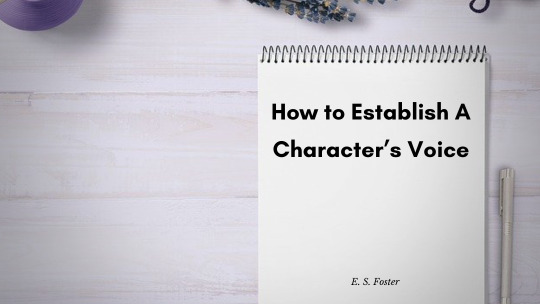
View On WordPress
13 notes
·
View notes
Text
Critiquing: Giving and Getting the Gold
So, what goes into a critique? What is it that makes it useful, or not? For openers, try to be positive. That doesn’t mean sugar-coating. It means finding something you can focus on in order to start on a positive note, even if most of the piece being reviewed needs work. Then you can move toward the areas that you found confusing or which bumped you out of the fictive dream.
Continue reading…
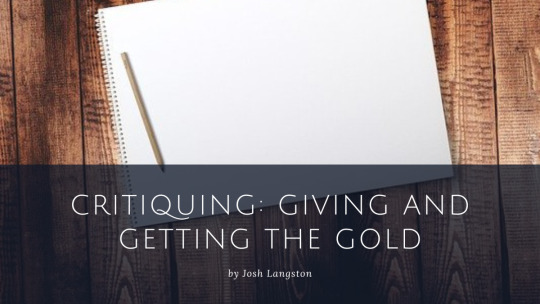
View On WordPress
3 notes
·
View notes
Text
“I write compulsively. I’ve got so many ideas, and I love to do it so much, I can’t not do it. I write the way some people do drugs.”
— Chuck Palahniuk
315 notes
·
View notes
Note
Hi! so according to my close friend who’s also my beta reader, i apparently have amazing descriptions when it comes to character movement and dialogue but what i lack is describing my surroundings, and according to her it makes her only able to imagine the characters ‘in a void’. how do i make my writing more immersive without constantly breaking character action to describe the surroundings (which seems to be all that i can do to avoid that effect)?
i know i’m probably struggling with this because i myself am the author so i can imagine my character surroundings perfectly fine, so how can i still spot and avoid this in the future?
Incorporating Surroundings Into Description
There are three tricks you can use to help you incorporate your character's surroundings into the scene:
1 - Incorporate description of the setting into the beginning of the scene to set the stage for where everything is about to unfold. For example:
The Hunger Games by Suzanne Collins, 2nd paragraph of chapter three, after Katniss describes being led into the Justice Building:
Once inside, I'm conducted to a room and left alone. It's the richest place I've ever been in, with thick, deep carpets and a velvet couch and chairs...
Outlander, by Diana Gabaldon, beginning of scene two, chapter five:
The laird received me in a room at the top of a flight of stone steps. It was a tower room, round, and rich with paintings and tapestries hung against the sloping walls...
2 - Have the characters interact with the environment throughout the scene. For example, your character could:
-- sit on furniture, peek inside a door, or look out a window
-- notice decor items like photographs or paintings
-- touch or fidget with an object, like skipping a rock on a lake
3 - Have the environment interact with your character throughout the scene:
-- change in weather or lighting and its effect on environment
-- sounds or smells related to the environment
-- movement or action related to the environment
So, using all three of these techniques... let's say this is a couple paragraphs in, after some exposition:
Andrea stepped onto the patio and marveled at the yard setup. Twenty-four chairs--twelve on each side of a white-carpeted aisle--were positioned in an arch facing the three-part trellis. Bright pink and deep purple flowers stood out against the white trellis, their green leafy tendrils and delicate petals draped daintily over the top of the arch. White fairy lights twinkled from the trellis and surrounding trees, and even in the golden sunlight of late afternoon, the effect was magical. At sunset, it would be breathtaking.
While the bridal party finished their own preparations, Andrea went to the bedroom where her child was putting on their wedding outfit. Outside, the low din of voices was beginning to build as the string quartet played soft music.
While Zen's best friend fussed with their hair, Andrea peeked outside to catch a glimpse of the spouse-to-be. They had chosen to wear a tuxedo with a short black skirt, and although they looked nervous, their eyes kept flickering to the house, and Andrea smiled, knowing their eyes would light up when they saw Zen in their amazing outfit.
So... this scene is going to be a wedding, and we set the stage early by describing the setup of the backyard wedding. In the next paragraph, we have the environment interact with our character by creating sound (string quartet, din of voices) which reminds the reader about the yard setup just beyond the bedroom. Finally, in the last paragraph, we have the POV character interact with the immediate environment (the bedroom) to peek outside and make observations that again root the reader in the outside environment (the wedding setup) but also reminds the reader that the character is currently inside the house, and the wedding will be outside the house.
By using all three of these tricks, you can avoid having your character exist in a void, because the setting is setup initially and actively exists for the reader throughout the scene.
Happy writing!
•••••••••••••••••••••••••••••••••
I’ve been writing seriously for over 30 years and love to share what I’ve learned. Have a writing question? My inbox is always open!
LEARN MORE about WQA
SEE MY ask policies
VISIT MY Master List of Top Posts
COFFEE & FEEDBACK COMMISSIONS ko-fi.com/wqa
147 notes
·
View notes
Text
Book Marketing: 20 Questions to Ask Yourself About Your Target Audience
Imagine this: you are a new author. You have a book published and ready for the public eye. You’ve been through all of the fundamental processes with editing, formatting, and designing. For the first time ever, you promote your book on social media. But wait – why is no one responding?
Continue reading Untitled
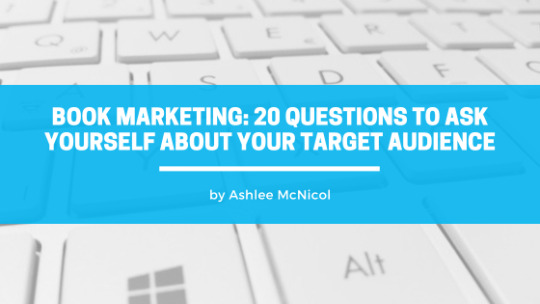
View On WordPress
7 notes
·
View notes
Text
“Writing is about hypnotizing yourself into believing in yourself, getting some work done, then unhypnotizing yourself and going over the material coldly.”
— Anne Lamott
344 notes
·
View notes
Text
Skip Google for Research
As Google has worked to overtake the internet, its search algorithm has not just gotten worse. It has been designed to prioritize advertisers and popular pages often times excluding pages and content that better matches your search terms
As a writer in need of information for my stories, I find this unacceptable. As a proponent of availability of information so the populace can actually educate itself, it is unforgivable.
Below is a concise list of useful research sites compiled by Edward Clark over on Facebook. I was familiar with some, but not all of these.
⁂
Google is so powerful that it “hides” other search systems from us. We just don’t know the existence of most of them. Meanwhile, there are still a huge number of excellent searchers in the world who specialize in books, science, other smart information. Keep a list of sites you never heard of.
www.refseek.com - Academic Resource Search. More than a billion sources: encyclopedia, monographies, magazines.
www.worldcat.org - a search for the contents of 20 thousand worldwide libraries. Find out where lies the nearest rare book you need.
https://link.springer.com - access to more than 10 million scientific documents: books, articles, research protocols.
www.bioline.org.br is a library of scientific bioscience journals published in developing countries.
http://repec.org - volunteers from 102 countries have collected almost 4 million publications on economics and related science.
www.science.gov is an American state search engine on 2200+ scientific sites. More than 200 million articles are indexed.
www.pdfdrive.com is the largest website for free download of books in PDF format. Claiming over 225 million names.
www.base-search.net is one of the most powerful researches on academic studies texts. More than 100 million scientific documents, 70% of them are free
212K notes
·
View notes
